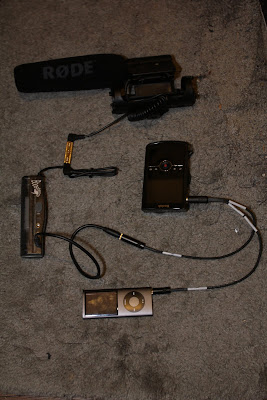While this method has been effective at reducing the noise caused by the AGC, it has also reduced the overall recording volume of the camera, which is a problem when working with soft spoken talent. When I ran into this problem, I was at a bit of a loss for a way to fix it. I emailed Deejay of DSLRfilmnoob.com, and after much thought, he suggested using a headphone amplifier to boost the volume of the mic heading into the camera, kind of like a preamp. What a genius idea!

I did some searching on the interwebs, and found many different types of headphone amps, at many different prices. The Boostaroo Headphone Amp was on the cheaper side, could be found at any Radio Shack, and would output amplified audio to 3 devices. Since it had 3 output jacks, I could send one into the camera, and plug a headset into another. Below is an example of how I attached the headphone amplifier to my camera. The Kodak Zi8 stood in for my T2i since I was using it to take the photo.

To explain: the Rode Video Mic is connected to one end of a 1/8 female to 1/8 female coupler. The input of the Boostaroo Headphone Amp is plugged into the other end of the coupler. In the first output of the Boostaroo is a 1/8 male to 1/8 male audio cable which connects to the mic input of the Sescom Cable. My MP3 player is plugged into the AGC Disable end of the Sescom Cable, and this is all connected to the External Mic jack on my "T2i".
It's not shown in the above image, but you can add a pair of headphones to the Boostaroo and monitor the audio before it reaches the camera. It should be noted that the ideal place to monitor audio is when it's been passed through the camera, however, because of the constant tone played by the MP3 player to disable the AGC, you would only hear noise in your headset. If however you have a DSLR with manual audio controls, and an external monitor, check out Deejay's headphone hack.
While the Boostaroo did increase the gain of the microphone in my tests, it only increased it by 10-15db which didn't make a significant difference. The Boostaroo also lacks any type of volume control, it's either on or off, and when it's off, it decreases the recording volume and introduces a lot of noise. Finally, the Boostaroo ended up being much larger and heavier then I anticipated.
Although I will be returning the Boostaroo, it did prove proof of concept, so in it's place I have ordered the Micca Fiio e5. This unit is much smaller and lighter, has volume control, is rechargeable, has a much higher output power then the Boostaroo, is cheaper then the Boostaroo, and can often be purchased with a Y splitter like the package I linked to above. With the Y splitter you can add your headset and still be able to monitor the audio.
When the Micca Fiio e5 shows up I'll put together a video showing how I set it all up, and I'll include some tests.



